MITSUBISHI MONTERO 1987 1.G Workshop Manual
Manufacturer: MITSUBISHI, Model Year: 1987, Model line: MONTERO, Model: MITSUBISHI MONTERO 1987 1.GPages: 284, PDF Size: 14.74 MB
Page 131 of 284
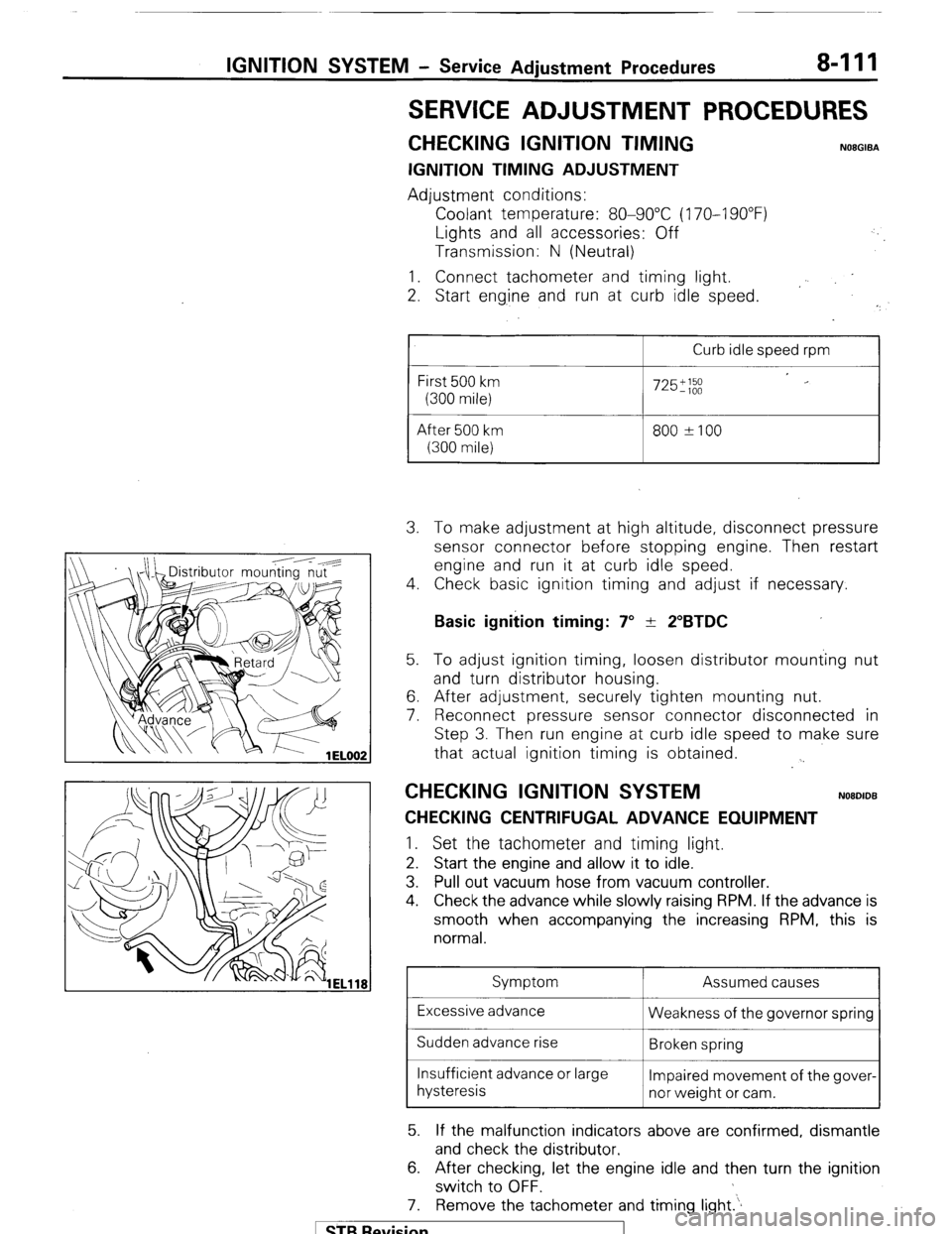
IGNITION SYSTEM - Service Adjustment Procedures 8-111
SERVICE ADJUSTMENT PROCEDURES
CHECKING IGNITION TIMING NOEGIBA
IGNITION TIMING ADJUSTMENT
Adjustment conditions:
Coolant temperature: 80-90°C (170-I 90°F)
Lights and all accessories: Off
Transmission: N (Neutral)
1. Connect tachometer and timing light.
2. Start eng.ine and run at curb idle speed.
I
Curb idle speed rpm
First 500 km
(300 mile)
After 500 km
(300 mile)
725';;;
800 ?I00 3. To make adjustment at high altitude, disconnect pressure
sensor connector before stopping engine. Then restart
engine and run it at curb idle speed.
4. Check basic ignition timing and adjust if necessary.
Basic ignition timing: 7” + 2”BTDC 5. To adjust ignition timing, loosen distributor mounting nut
and turn distributor housing.
6. After adjustment, securely tighten mounting nut.
7. Reconnect pressure sensor connector disconnected in
Step 3. Then run engine at curb idle speed to make sure
that actual ignition timing is obtained.
. .
CHECKING IGNITION SYSTEM NOBDIDB
CHECKING CENTRIFUGAL ADVANCE EQUIPMENT 1.
Set the tachometer and timing light.
2. Start the engine and allow it to idle.
3. Pull out vacuum hose from vacuum controller.
4. Check the advance while slowly raising RPM. If the advance is
smooth when accompanying the increasing RPM, this is
normal.
Symptom Assumed causes
Excessive advance
Weakness of the governor spring
Sudden advance rise
Broken spring
Insufficient advance or large
Impaired movement of the gover-
hysteresis
nor weight or cam.
5. If the malfunction indicators above are confirmed, dismantle
and check the distributor.
6. After checking, let the engine idle and then turn the ignition
switch to OFF.
7. Remove the tachometer and timing light.‘.
1 STB Revision
Page 132 of 284
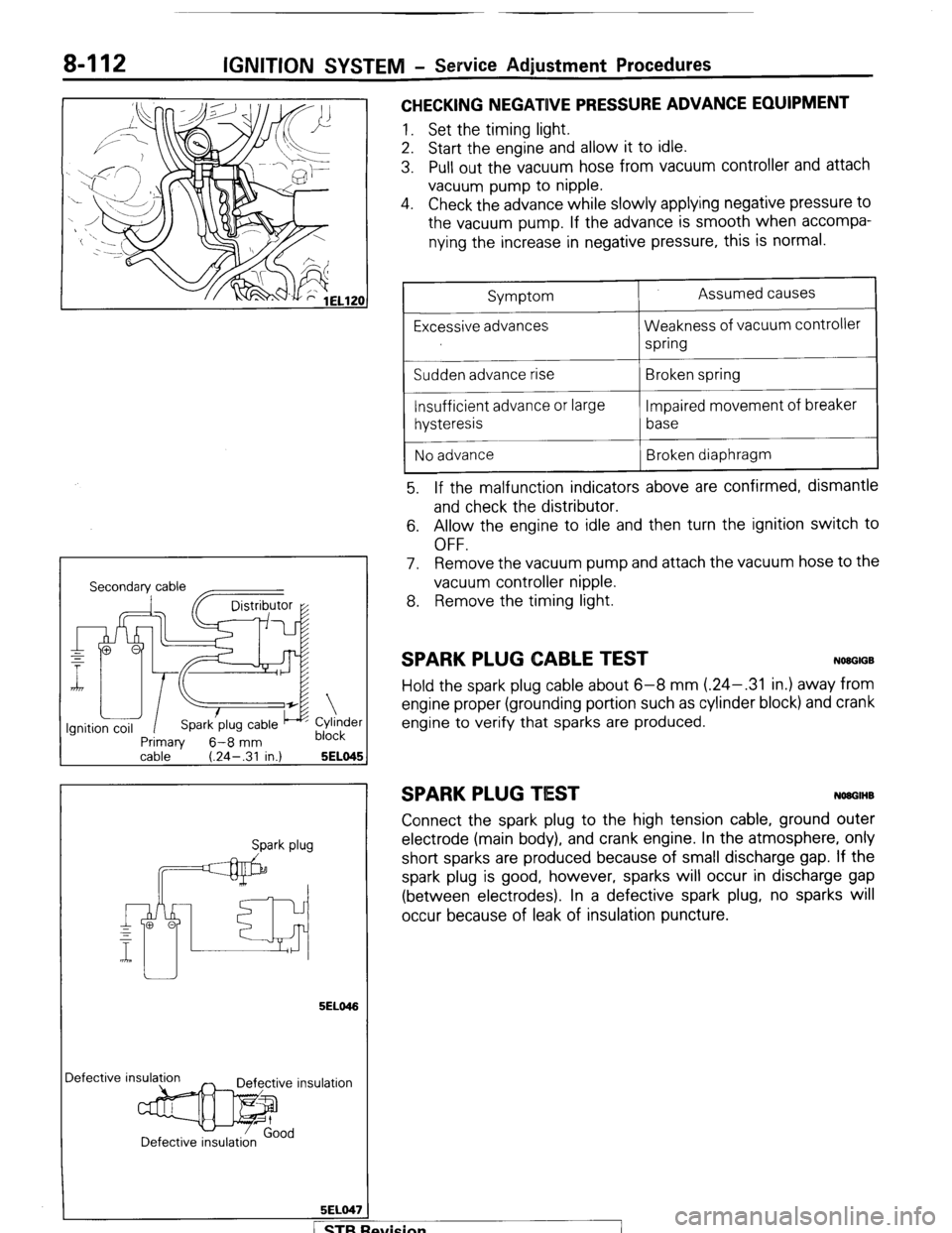
8-112 IGNITION SYSTEM - Service Adjustment Procedures
CHECKING NEGATIVE PRESSURE ADVANCE EQUIPMENT
1. Set the timing light.
2. Start the engine and allow it to idle.
3. Pull out the vacuum hose from vacuum controller and attach
vacuum pump to nipple.
4. Check the advance while slowly applying negative pressure to
the vacuum pump. If the advance is smooth when accompa-
nying the increase in negative pressure, this is normal.
Secondary cable
~~
Primaw 6-8 mm
Cylinder
block
cable ’ (.24-.31 in.) 5ELO45 1
Spark plug
5ELO46
Iefective insula
5ELO47
/
Symptom
Excessive advances
Sudden advance rise
Insufficient advance or large
hysteresis
No advance Assumed causes
Weakness of vacuum controller
spring
Broken spring
Impaired movement of breaker
base
Broken diaphragm
5. If the malfunction indicators above are confirmed, dismantle
and check the distributor.
6. Allow the engine to idle and then turn the ignition switch to
OFF.
7. Remove the vacuum pump and attach the vacuum hose to the
vacuum controller nipple.
8. Remove the timing light.
SPARK PLUG CABLE TEST NWGIGB
Hold the spark plug cable about 6-8 mm (.24-.31 in.) away from
engine proper (grounding portion such as cylinder block) and crank
engine to verify that sparks are produced.
SPARK PLUG TIEST NOUGIHB
Connect the spark plug to the high tension cable, ground outer
electrode (main body), and crank engine. In the atmosphere, only
short sparks are produced because of small discharge gap. If the
spark plug is good, however, sparks will occur in discharge gap
(between electrodes). In a defective spark plug, no sparks will
occur because of leak of insulation puncture.
fvision
I
Page 133 of 284
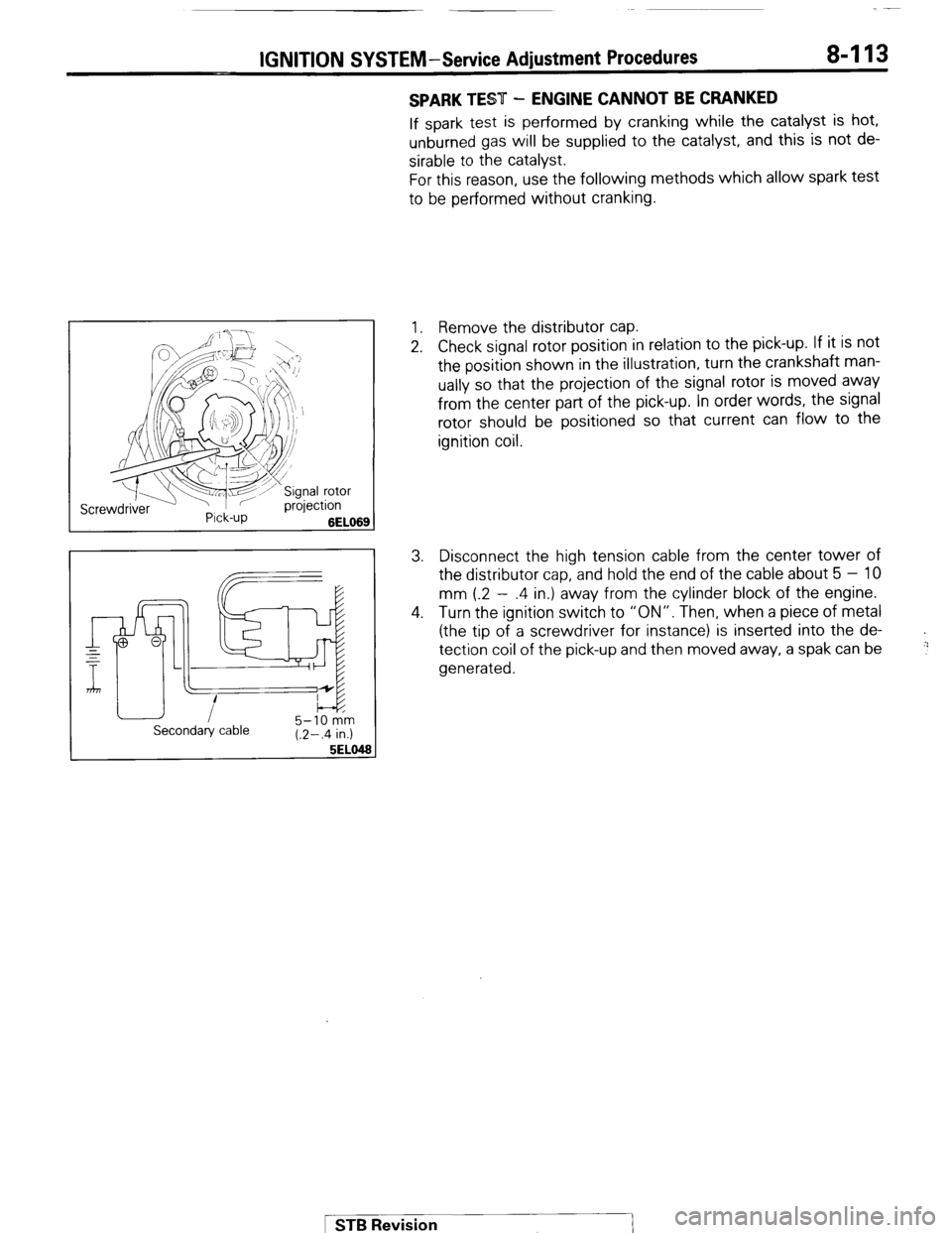
IGNITION SYSTEM-Service Adjustment Procedures 8-113
SPARK TEST - ENGINE CANNOT BE CRANKED
If spark test is performed by cranking while the catalyst is hot,
unburned gas will be supplied to the catalyst, and this is not de-
sirable to the catalyst.
For this reason, use the following methods which allow spark test
to be performed without cranking.
1. Remove the distributor cap.
2. Check signal rotor position in relation to the pick-up. If it is not
the position shown in the illustration, turn the crankshaft man-
ually so that the projection of the signal rotor is moved away
from the center part of the pick-up. In order words, the signal
rotor should be positioned so that current can flow to the
ignition coil.
3. Disconnect the high tension cable from the center tower of
the distributor cap, and hold the end of the cable about 5 - 10
mm (.2 - .4 in.) away from the cylinder block of the engine.
4. Turn the ignition switch to “ON”. Then, when a piece of metal
(the tip of a screwdriver for instance) is inserted into the de-
tection coil of the pick-up and then moved away, a spak can be
generated.
+
!:’
Secondary cable 5-10 km
(.2-.4 in.)
5EL0
1 STB Revision
Page 134 of 284
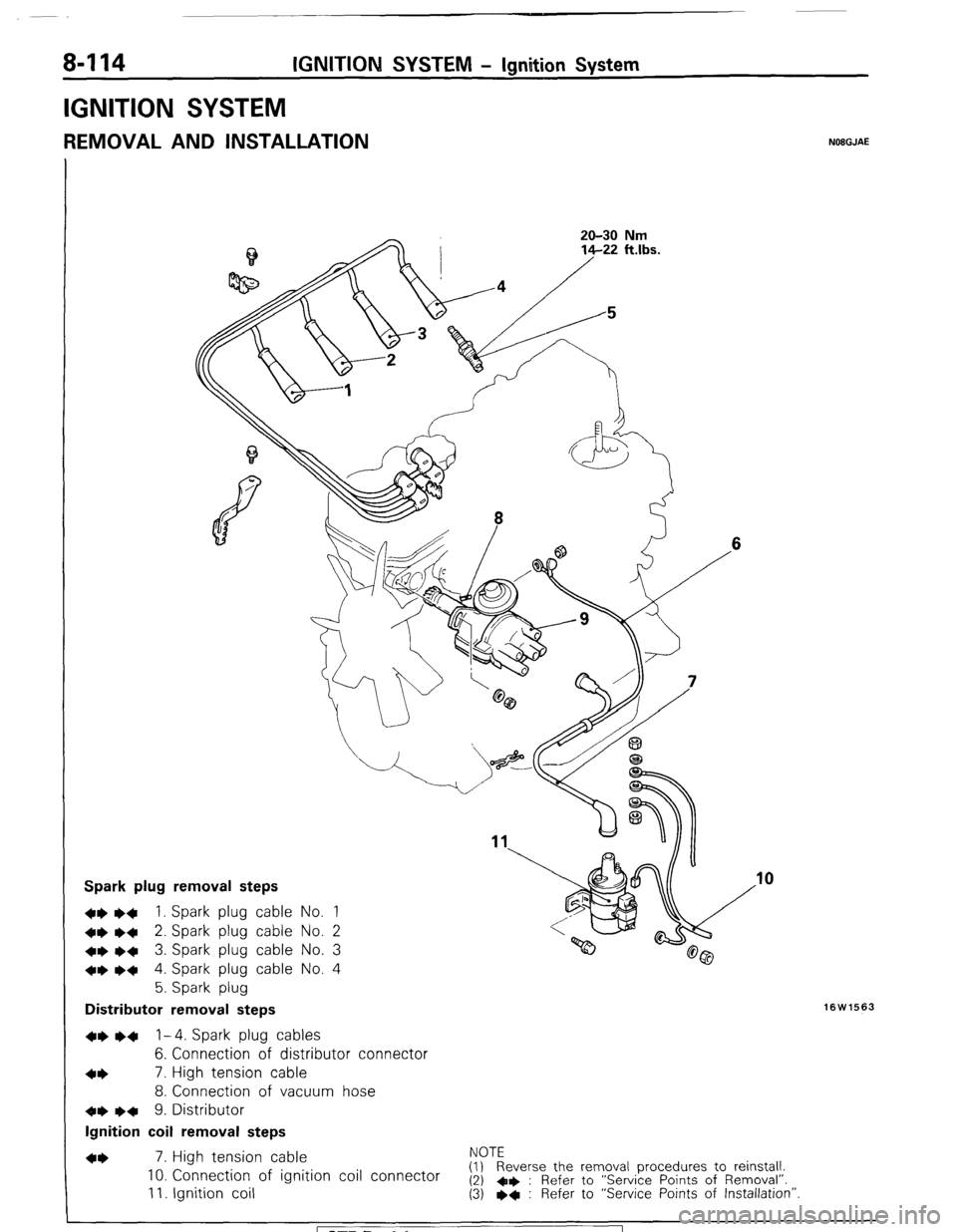
8-114 IGNITION SYSTEM - Ignition System
IGNITION SYSTEM
REMOVAL AND INSTALLATION NOEGJAE
20-30
Nm
Spark plug removal steps
+e l
+ 1. Spark plug cable No. 1
~~ ~~ 2. Spark plug cable No. 2
+e e+ 3. Spark plug cable No. 3
*e e+ 4. Spark plug cable No. 4
5. Spark plug
Distributor removal steps
16W1563
~~ l + 1-4. Spark plug cables
6. Connection of distributor connector
+* 7. High tension cable
8. Connection of vacuum hose
de l
q 9. Distributor
Ignition coil removal steps
7. High tension cable NOTE
10. Connection of ignition coil connector (1) Reverse the removal procedures to reinstall.
(2) +e : Refer to “Service Points of Removal”. 11. Ignition coil (3) l + : Refer to “Service Points of Installation”
I
1 STB Revision
Page 135 of 284
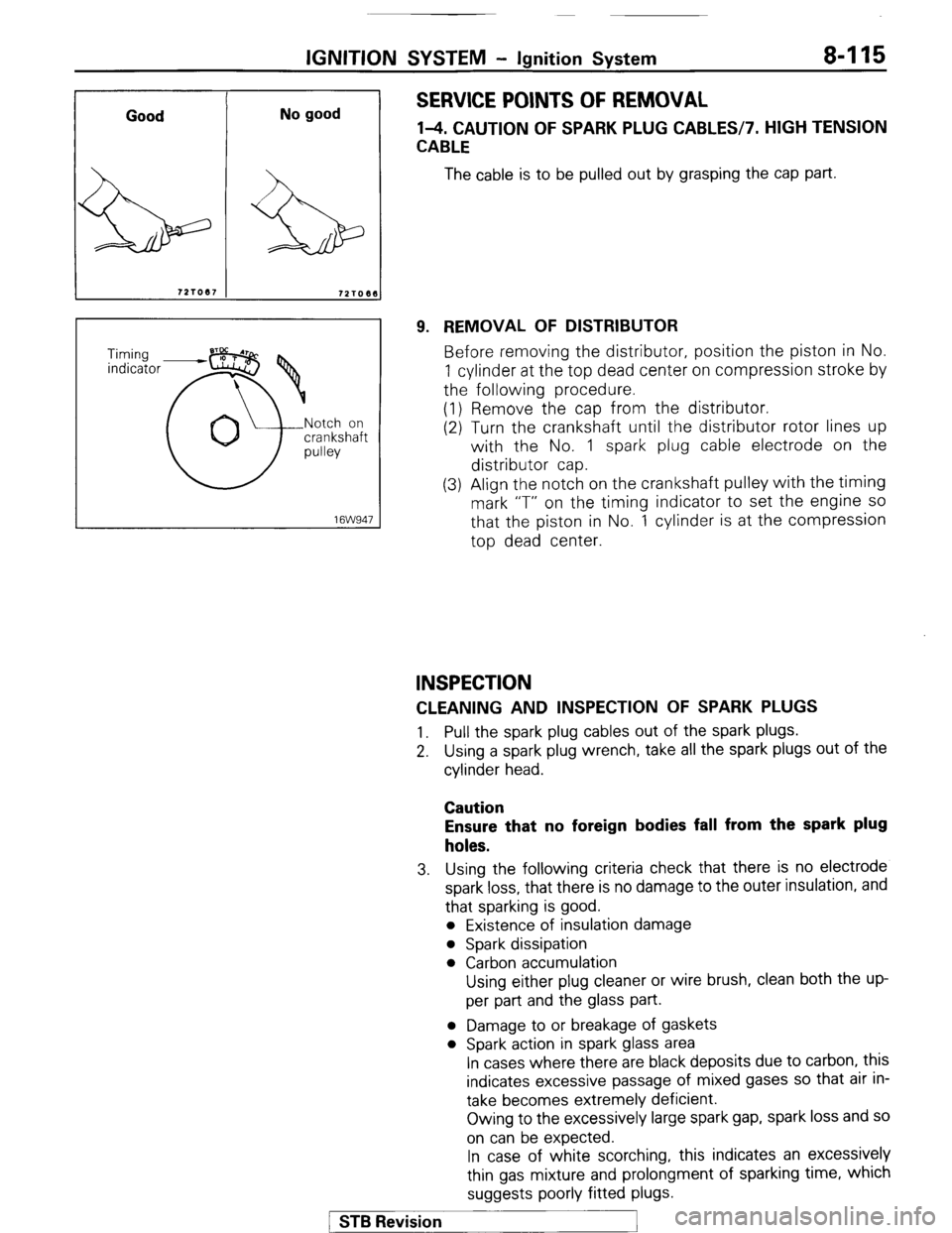
IGNITION SYSTEM - Ignition Svstem 8-115
Good No good
721017
72T06t
16W947
SERVICE POINTS OF REMOVAL
l-4. CAUTION OF SPARK PLUG CABLES17. HIGH TENSION
CABLE
The cable is to be pulled out by grasping the cap part.
9. REMOVAL OF DISTRIBUTOR
Before removing the distributor, position the piston in No.
1 cylinder at the top dead center on compression stroke by
the following procedure.
(1) Remove the cap from the distributor.
(2) Turn the crankshaft until the distributor rotor lines up
with the No. 1 spark plug cable electrode on the
distributor cap.
(3) Align the notch on the crankshaft pulley with the timing
mark “T” on the timing indicator to set the engine
SO
that the piston in No. 1 cylinder is at the compression
top dead center.
INSPECTION
CLEANING AND INSPECTION OF SPARK PLUGS
1. Pull the spark plug cables out of the spark plugs.
2. Using a spark plug wrench, take all the spark plugs out of the
cylinder head.
Caution
Ensure that no foreign bodies fall from the spark plug
holes.
3. Using the following criteria check that there is no electrode
spark loss, that there is no damage to the outer insulation, and
that sparking is good.
l Existence of insulation damage
l Spark dissipation
l Carbon accumulation
Using either plug cleaner or wire brush, clean both the up-
per part and the glass part.
l Damage to or breakage of gaskets
l Spark action in spark glass area
In cases where there are black deposits due to carbon, this
indicates excessive passage of mixed gases so that air in-
take becomes extremely deficient.
Owing to the excessively large spark gap, spark loss and so
on can be expected.
In case of white scorching, this indicates an excessively
thin gas mixture and prolongment of sparking time, which
suggests poorly fitted plugs.
/ STB Revision
1
Page 136 of 284
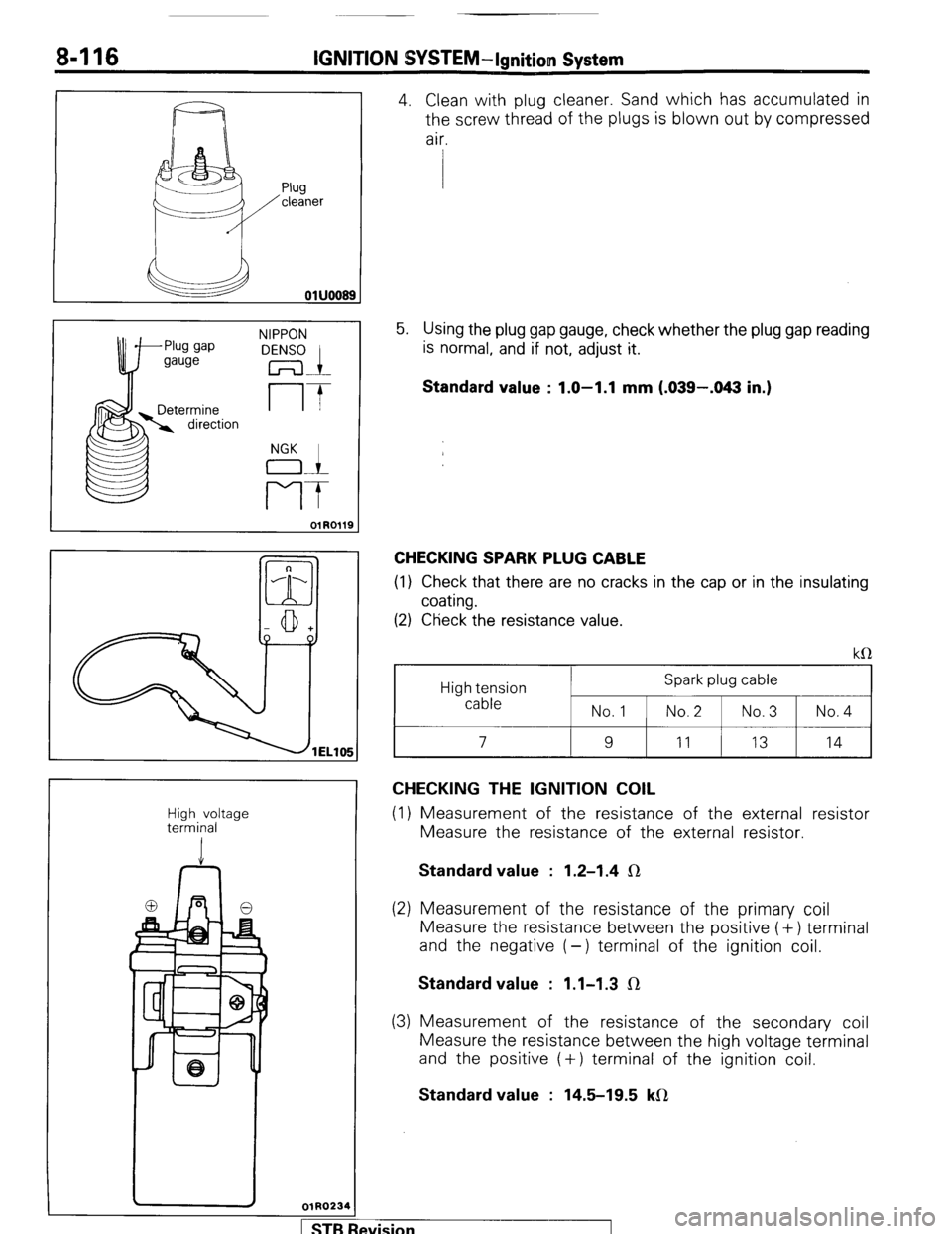
8-116 IGNITION SYSTEM-Ignition System
Plug
cleaner
OlUOO89
Plug gap
gauge NIPPON
termine
rl
direction
High voltage
terminal
01R0234
4. Clean with plug cleaner. Sand which has accumulated in
the screw thread of the plugs is blown out by compressed
air.
5. Using the plug gap gauge, check whether the plug gap reading
is normal, and if not, adjust it.
Standard value : 1.0-1.1 mm (.039-.043 in.)
CHECKING SPARK PLUG CABLE
(1) Check that there are no cracks in the cap or in the insulating
coating.
(2) Ctieck the resistance value.
High tension
cable Spark plug cable
No.1 1 No.2 1 No.3 1 No.4
I 9
I
11
I 13 I 14
CHECKING THE IGNITION COIL
(1) Measurement of the resistance of the external resistor
Measure the resistance of the external resistor. Standard value : 1.2-1.4 IR
(2) Measurement of the resistance of the primary coil
Measure the resistance between the positive (+) terminal
and the negative (-) terminal of the ignition coil. Standard value : 1.1-1.3 IR
(3) Measurement of the resistance of the secondary coil
Measure the resistance between the high voltage terminal
and the positive (+) terminal of the ignition coil. Standard value : 14.5-19.5 kfl
wision I
Page 137 of 284
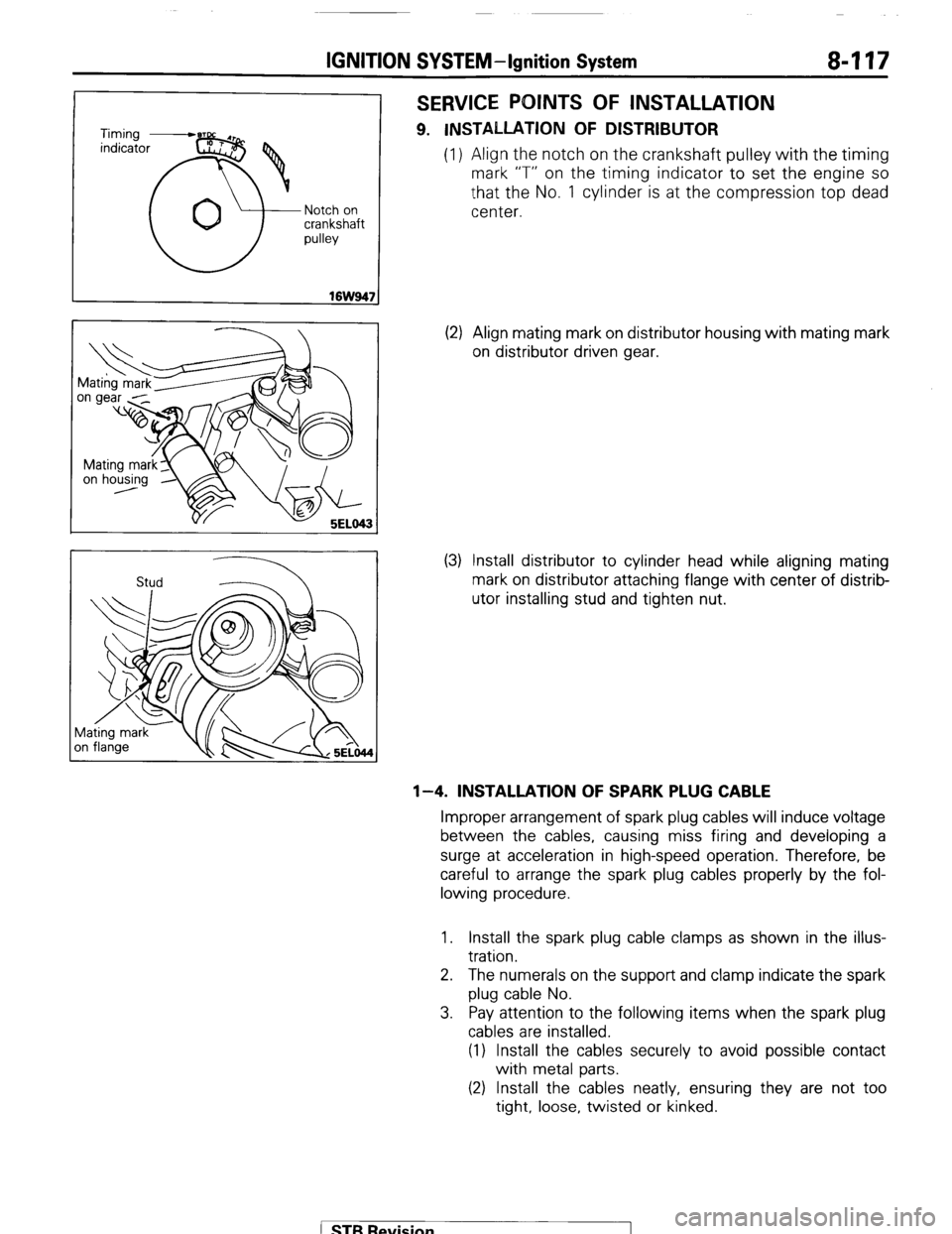
IGNITION SYSTEM-Ignition System 8417
Notch on
crankshaft
pulley
Stud 2
SERVICE POINTS OF INSTALLATION
9. INSTALLATION OF DISTRIBUTOR
(1) Align the notch on the crankshaft pulley with the timing
mark “T” on the timing indicator to set the engine so
that the No. 1 cylinder is at the compression top dead
center.
(2) Align mating mark on distributor housing with mating mark
on distributor driven gear.
(3) Install distributor to cylinder head while aligning mating
mark on distributor attaching flange with center of distrib-
utor installing stud and tighten nut.
l-4. INSTALLATION OF SPARK PLUG CABLE
Improper arrangement of spark plug cables will induce voltage
between the cables, causing miss firing and developing a
surge at acceleration in high-speed operation. Therefore, be
careful to arrange the spark plug cables properly by the fol-
lowing procedure.
1. Install the spark plug cable clamps as shown in the illus-
tration.
2. The numerals on the support and clamp indicate the spark
plug cable No.
3. Pay attention to the following items when the spark plug
cables are installed.
(1) Install the cables securely to avoid possible contact
with metal parts.
(2) Install the cables neatly, ensuring they are not too
tight, loose, twisted or kinked.
( STB Revision
Page 138 of 284
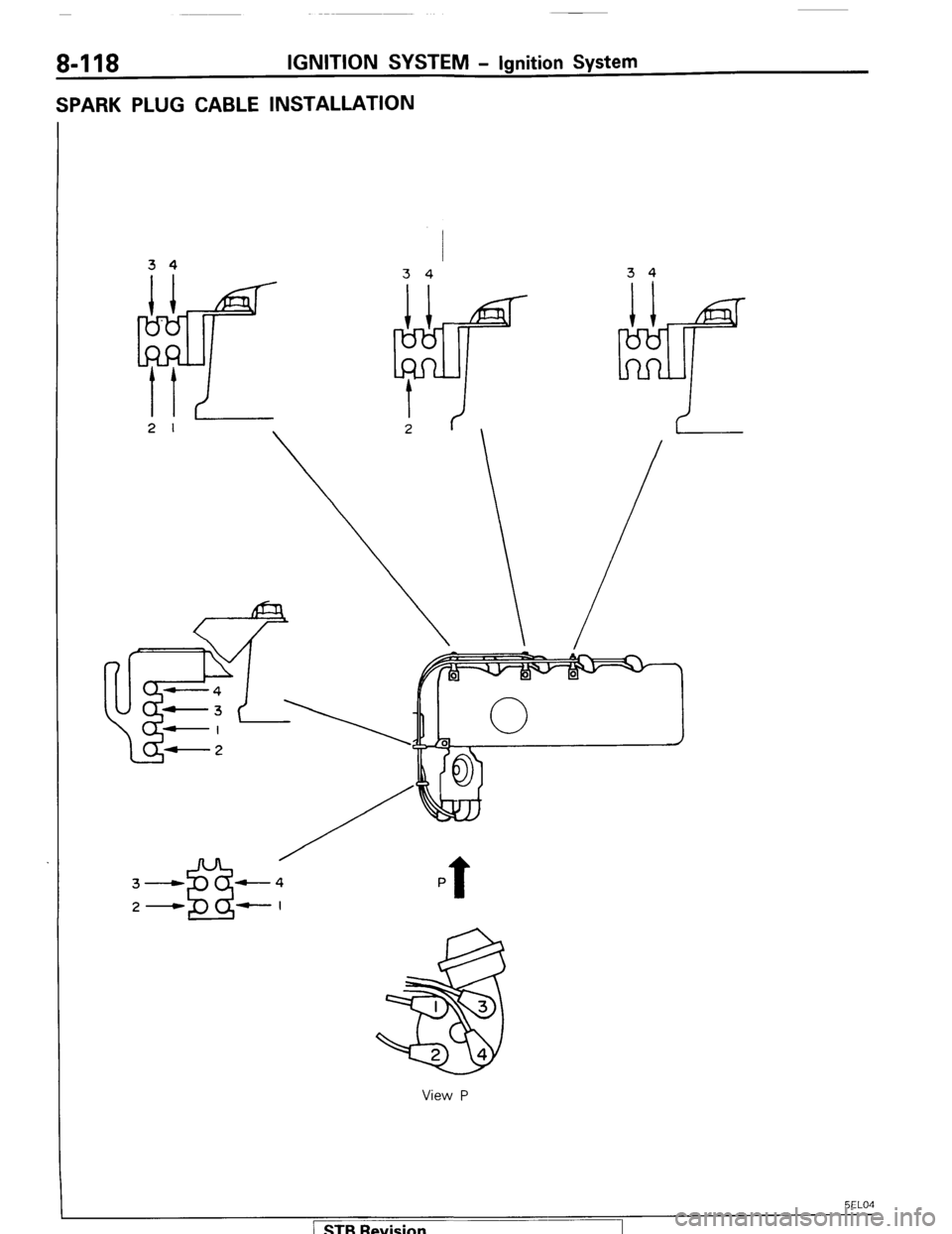
8-118 IGNITION SYSTEM - Ignition System
SPARK PLUG CABLE INSTALLATION
I( 1
-4
-3
3
-1
-2
3
I 3
2 4
View P
/ STB Revision
5EL04
1
Page 139 of 284
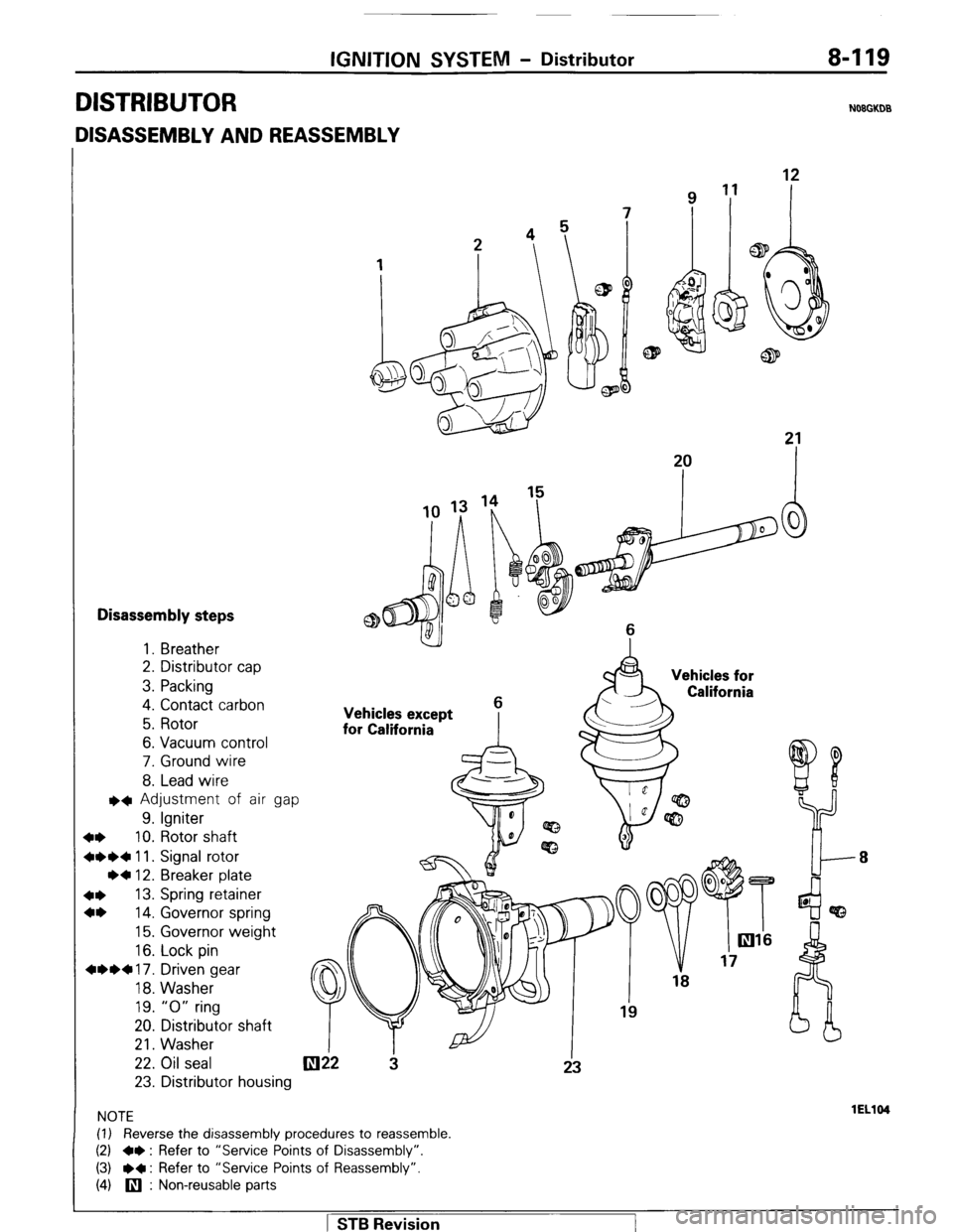
IGNITION SYSTEM - Distributor
DISTRIBUTOR
DISASSEMBLY AND REASSEMBLY
8-119
Disassembly steps
1. Breather
2. Distributor cap
3. Packing
4. Contact carbon
5. Rotor
6. Vacuum control
7. Ground wire
8. Lead wire
l + Adjustment of air gap
9. Igniter
4* 10. Rotor shaft
+*** 11. Signal rotor
l * 12. Breaker plate
4* 13. Spring retainer
4* 14. Governor spring
15. Governor weight
16. Lock pin
- Vehicles for
California
Vehicles except
for California
8
4**+ 17. Driven gear
18. Washer
19. “0” ring
20. Distributor shaft
21. Washer
22. Oil seal
23. Distributor housing
NOTE
(1) Reverse the disassembly procedures to reassemble.
(2) +e : Refer to “Service Points of Disassembly”.
(3) Hw: Refer to “Service Points of Reassembly”.
(4)
q : Non-reusable parts
lEL104 1 STB Revision
Page 140 of 284
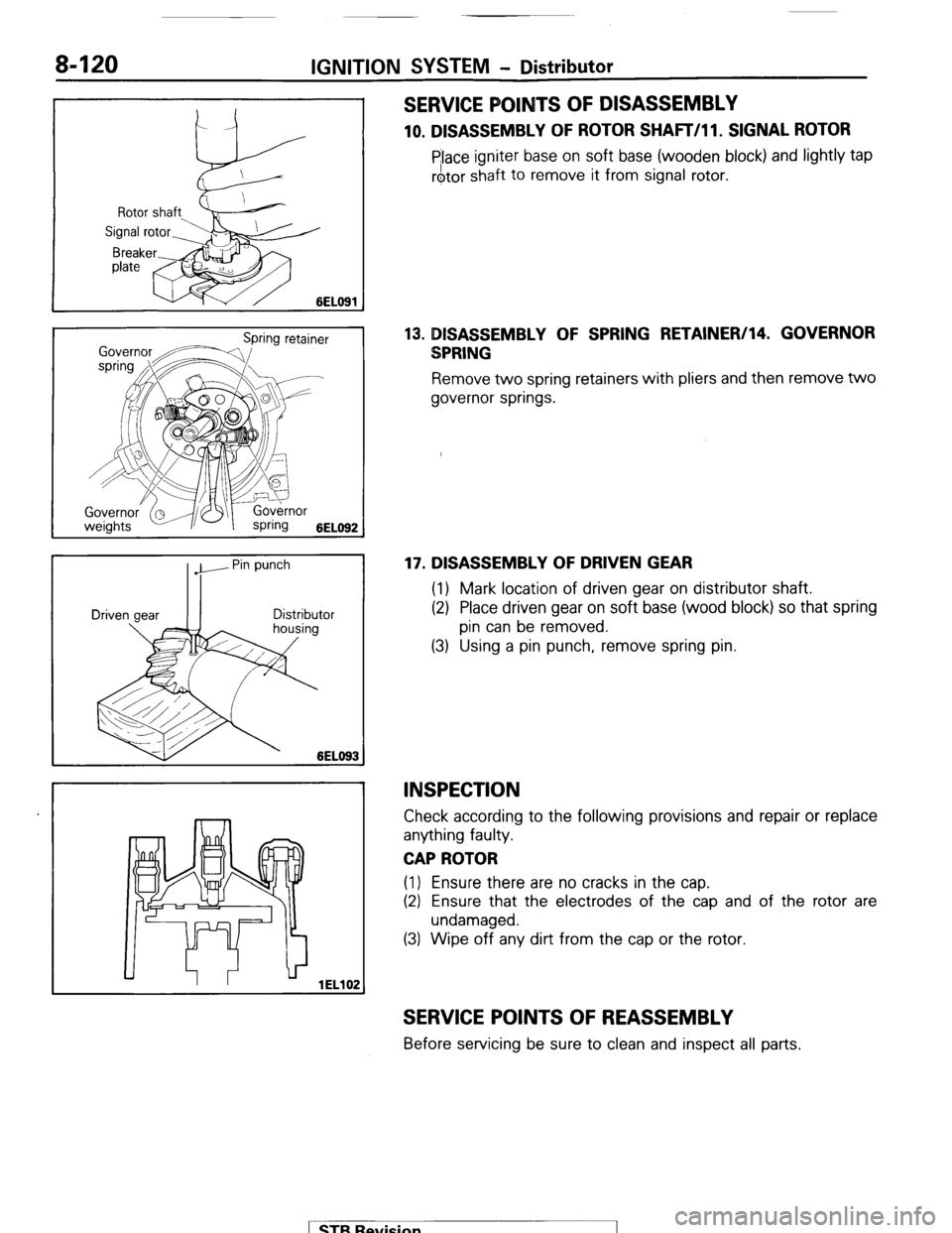
8-120 IGNITION SYSTEM - Distributor
6ELO6i
ti Pin punch
II
1ELlOi
SERVICE POINTS OF DISASSEMBLY
10. DISASSEMBLY OF ROTOR SHAFT/l 1. SIGNAL ROTOR
Place igniter base on soft base (wooden block) and lightly tap
rotor shaft to remove it from signal rotor.
13. DISASSEMBLY OF SPRING RETAINERI14. GOVERNOR
SPRING
Remove two spring retainers with pliers and then remove two
governor springs.
17. DISASSEMBLY OF DRIVEN GEAR
(1) Mark location of driven gear on distributor shaft.
(2) Place driven gear on soft base (wood block) so that spring
pin can be removed.
(3) Using a pin punch, remove spring pin.
INSPECTION
Check according to the following provisions and repair or replace
anything faulty.
CAP ROTOR
(1) Ensure there are no cracks in the cap.
(2) Ensure that the electrodes of the cap and of the rotor are
undamaged.
(3) Wipe off any dirt from the cap or the rotor.
SERVICE POINTS OF REASSEMBLY
Before servicing be sure to clean and inspect all parts.
1 STB Revision